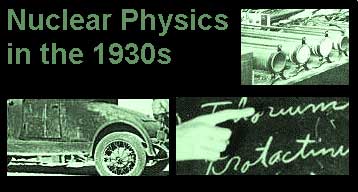

|
|
Much of the research in nuclear science in the 1930s focused on implications of radioactivity. By the first decades of the century, scientists had explained the phenomenon of radioactivity—discovered by Henri Becquerel in 1896—as the transmutation of certain chemical elements, with the emission of different kinds of radiation called alpha, beta, and gamma rays. Alpha rays were identified as nuclei of helium atoms, beta rays as electrons, and gamma rays as electromagnetic waves more energetic than X-rays.
The discovery of the neutron in 1932 by James Chadwick, a physicist at the Cavendish Laboratory in Cambridge, allowed physicists to theorize that the nucleus was composed of protons and neutrons. The number of protons in the nucleus equaled the atomic number of the element, with the positive charge of the protons balanced by an equal number of electrons in the atom outside the nucleus. Different atoms of the same chemical element, however, could have different numbers of neutrons in the nucleus; a variety of atom with a particular number of neutrons was called an isotope. Certain isotopes were unstable, due to forces arising from particular combinations of protons and neutrons, and would decay radioactively into new elements. |
 |
|